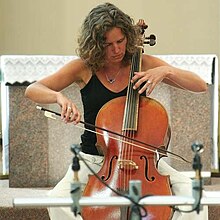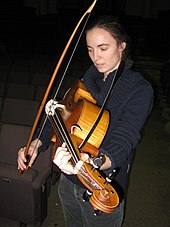Violoncello piccolo
The term violoncello piccolo was used for a relatively short period of time in the Baroque era and at that time most likely referred to a five-string violin instrument in arm position. In the course of historicizing performance practice, this instrument, derived from the viola , is now mostly called the “ viola pomposa ”. “Violoncello piccolo”, on the other hand, is usually used today to describe a five-string violoncello in knee position. There are only a few historical sources, so the matter has not yet been clearly clarified.
Definition
18th century
The term violoncello piccolo can be found for the first time from 1724 in copies of seven cantatas by Johann Sebastian Bach as a solo instrument of one aria of the cantata.
In the Musical Lexicon of 1732, Johann Gottfried Walther mentions the following under the heading cello:
“Violoncello, the Bassa di Viola and Viola di Spala are small bass violins, compared to the larger ones with 5 and probably also with 6 strings, on which one can do all kinds of quick things, variations and manners easier than on the big machines; In particular, the viola di spala or shoulder viole has a great effect in the accompaniment, because it can cut through strongly and express the tones purely. It is attached to the ribbon on the chest and, as it were, thrown onto the right shoulder, so it has nothing to stop or prevent its resonance in the least ... "
The four-stringed ones are tuned like a viola CGda and go to the a.
A few years later, in 1766, the name appears in a Breitkopf sheet music catalog in the following form: "Violoncello piccolo o Violoncello da braccia." The catalog therefore indicates an instrument in arm position.
The Historisch-Biographische Lexikon der Tonkünstler from 1790, edited by Ernst-Ludwig Gerber, writes the following about Bach in the article Viola pomposa : “The stiff way with which the violon cells were treated in his time, with the lively basses in his works, compelled him , to an invention that he called the viola pomposa; this comfortable instrument enabled the player to more easily execute the existing high and rapid passages. "
The Bach cantatas are the only known sources of music for this instrument. The demands on the instrument are different: the highest note requires a 1 in one cantata, b 1 in three cantatas, h 1 in one cantata and c 2 in two cantatas, a string that is tuned higher than the top string a of the violoncello . The lowest note of the ambitus differs more; In no cantata are longer passages to be played below G, which would require a powerful bass. The cantatas BWV 6 , BWV 115 and BVW 180 are in alto and bass keying (analogous to the keying in the 6th suite for violoncello by Bach), the cantatas BWV 41 , BWV 49 and BWV 85 are in octaved treble clef rsp. Notated for lower notes in the bass clef and thus correspond to the notation of cello music as it appeared in the pre-classical period, but was not yet common at that time. The cantata He calls his sheep by name , BWV 175, with tenor-bass coding corresponds to the one customary for the cello. This cantata also differs from the others in that the part can be played on a four-string cello with the technology of the time without restrictions.
So there has been some evidence of a five-string instrument in arm position since the cantatas were first written. The somewhat different ambitus in the various cantatas could indicate that the instruments of the cantatas differ slightly, e.g. B. in their size, differentiated; the designation “violoncello piccolo” for the cantata BWV 175 is only understandable for reasons of sound, but not for technical reasons.
Thus, in the 18th century, violoncello piccolo, viola pomposa and viola da Spal (l) a were probably similar instruments, five-string violas in the tuning CGdae 1 .
20th century
In recent years there have been recordings by well-known baroque cellists ( Anner Bylsma , Pieter Wispelwey , Christophe Coin and others) with a five-string violoncello in normal or slightly smaller scale. The corresponding Bach cantatas, the 6th cello suite by Bach and other music were played.
There is historical evidence of such a five-string violoncello.
The first violoncello made by Antonio Stradivari (today preserved) is dated 1667, two years after the first musical historical record of the word violoncello in a collection by Arresti . It is basically a hybrid of bass viol and bass violin, a bass instrument due to its size, and made in the peg box with holes for five pegs, and thus for five strings. Five-string basses are e.g. B. described in the Syntagma musicum as Bas-Geig de bracio as early as 1600. In the following decades, however, there was no historical evidence for a five-string instrument of texture and tuning, as it is called today as the "violoncello piccolo".
Musical references can be found in the six suites for cello solo by Johann Sebastian Bach, preserved in copies from 1719 . It can be assumed that Bach mentioned what could be understood by the term violoncello at the time the suites were created (around 1720) , namely in suites 1 to 4 an instrument similar to the one that is common today, in the fifth suite an instrument in the mood, as was customary in Bologna until 1700 (CGdg), and in the sixth suite a "violoncelle a 5 acordes CGdae 1 ", a five-string instrument. The suite requires a full bass in several places, which indicates a large instrument (in knee position).
It is possible that a violoncello sonata by Domenico Gabrielli (contained in the manuscript as alcuni ricercari per violoncello e basso continuo , Bologna 1689) was written for a five-string instrument in the tuning CGdgd 1 , since a chord in the second movement can only be executed in this way.
According to this, there is little evidence of the use of such an instrument in the first half of the 18th century. An anonymous English pen drawing " Handel directing an oratorio" (approx. 1740, British Museum, Mansell Collection) depicts a standing cellist with a five-string instrument. A caricature of the London cello virtuoso Giacomo Cervetto around 1750 as "Nosey" shows him also with a five- string instrument Violoncello. Some high baroque cello music, e.g. B. by Michel Corrette , Leonardo Leo , Francesco Scipriani , Pasqualino de Marzis and by Georg Philipp Telemann , was possibly intended for this instrument because it is technically unusually out of the ordinary and requires high registers with the instruments of the time and the technology of that time are only inconvenient to carry out. In the five volumes of traditional cello sonatas by Jean-Baptiste Masse , according to the title page one of the Vingt-quatre Violons du Roy , there are not only exceptionally high passages, but also chords in some sonatas that cannot be performed on a four-string violoncello. There is evidence that the violin bass, the basse de violon, appeared in France both in the form of a four-string cello and as a five-string cello (in the tuning CGda-d1).
Due to its design, the five-string cello is quieter than the four-string. With the development of play at higher altitudes , it apparently went out of use after 1750.
However, since viola pomposa and violoncello piccolo of today's designation are tuned in the same way and sound similar due to the five-string structure (fine, nasal, sweet), there is no musically any objection to using them alternately for the same task.
literature
Primary literature
- Johann Sebastian Bach: Manuscripts of the cantatas BWV 6, 49, 85 and 175 . bachdigital.de.
- Scribe unknown: Manuscript of the Ricercari by Domenico Gabrielli . Biblioteca Estense Universitaria , Modena 1689.
- Michel Corrette: Les délices de la solitude. Sonates, pour le Violoncelle, Viole, Basson. Avec la Basse Continue cipher Oeuvre XX . Paris 1739.
- Georg Philipp Telemann: The Faithful Music Master. Sonata for Solo Cello in D major . Hamburg 1728.
- Johann Gottfried Walther: Musical Lexicon . Bärenreiter, Kassel 1953, ISBN 3-7618-0807-0 , p. 637 (reprint of the Leipzig edition 1732).
- C. René Hirschfeld: Dance of Noeck for 5-string cello . Publisher 4'33 "(ISMN = M-50098-295-1).
Secondary literature
- Friedrich Blume (Ed.): Music in the past and present. General encyclopedia of music, founded by Friedrich Blume. Second, revised edition published by Ludwig Finscher . Bärenreiter, Kassel u. a, S. 1 1025, 6 plate 25, 12 1526, 13 1683 ff .
- David D. Boyden: The History of Violin Playing from Its Beginnings to 1761 . Schott, Mainz 1971, p. 49 ff .
- Mary Cyr: Style and Performance for Bowed String Instruments in French Baroque Music . Ashgate Publishing Company, Burlington 2012, ISBN 978-1-4094-0569-6 .
- Ulrich Drüner: Violoncello piccolo and viola pomposa with Johann Sebastian Bach. On questions of identity and playing style of these instruments . In: New Bach Society (Ed.): Bach Yearbook . Vol. 73. Evangelische Verlagsanstalt, 1987, ISSN 0084-7682 , p. 85-112 .
- Alfred Dürr : Johann Sebastian Bach. The cantatas . 8th edition. Bärenreiter, Kassel u. a. 2000, ISBN 3-7618-1476-3 , pp. 55 f .
- Ernst Ludwig Gerber: Lexicon of the Tonkünstler . Leipzig 1814.
- W. Henry Hill, Arthur F. Hill, Alfred E. Hill: Antonio Stradivari . Dover Publications, New York 1963, ISBN 0-486-20425-1 , pp. 114 ff .
- Paul R. Laird: The Baroque Cello Revival . Scarecrow Press, 2004, ISBN 978-0-8108-5153-5 , pp. 12 f .
- Annette Otterstedt: The viol. Cultural history and practical guide . Bärenreiter, Kassel u. a. 1994, ISBN 3-7618-1152-7 , pp. 85 .


